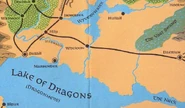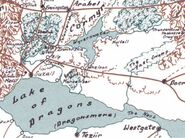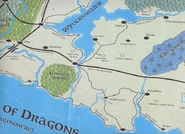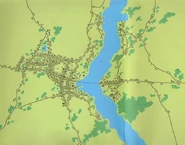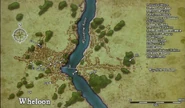However, if you can update it or think of a way to further improve it, then please feel free to contribute.
Wheloon (pronounced: /weɪˈluːn/ way-LOON[6]), sometimes nicknamed the Jade Towers, was a town and later small city in the kingdom of Cormyr in interior Faerûn. It lay at the junction of the Wyvernflow River and the Way of the Manticore and at the end of the Hullack Trail in southeastern Cormyr.[1][2][3][4][7][6][8][9]
Language[]
People and things from here were called "Whelunian".[4]
History[]
Early history[]
Predating Wheloon and the ferry was the God's Grove, a shrine to Silvanus and duskwood grove to the east.[2] Also built before Wheloon's founding was a so-called citadel built into a bluff north of the site. Later ruined, nothing more than the crumbling foundations inhabited by displacer serpents would remain by the 1370s DR.[10]
Originally a small thorp that lived off the trade of river crossings on the Wyvern Ferry Route, Wheloon slowly developed as trade along the Way of the Manticore increased and more ships starting using the Wyvernflow. It grew into a town based around the ferry.[1][2][7][6][9] The Harvest Hall temple of Chauntea was built around this time.[2]
Although Wheloon sat at the crossing of two of Cormyr's most important travel routes, it usually played only a minor role in Cormyrean history prior to 1374 DR.[2]
In the Year of the Thirsty Sword, 900 DR, King Galaghard III's army, the Glory of Cormyr, fought a battle against the Witch Lords and their undead forces at the fords of Wheloon, overrunning them but unable to achieve a final victory. They eventually drove them to the Vast Swamp and defeated them there.[2][11][12] This was the last historical event significant to Cormyr to occur in Wheloon until 1374 DR.[2]
Modern History[]
Wheloon was one of a number of places captured by the Lost King Gondegal in the Year of the Dragon, 1352 DR. Like the others, his mercenary troops occupied and pillaged the town before being ousted by the Purple Dragons as Gondegal's eight-day kingdom fell.[13]
During the Time of Troubles, in early Eleint of the Year of Shadows, 1358 DR, Cyric and some of his Zhentilar force visited Wheloon as they passed through Cormyr. Cyric left at least one of his agents there to interfere with Kelemvor Lyonsbane, Midnight, and Adon. Shortly after they arrived, Kelemvor was framed for the robbery and murder of a local merchant, with Cyric's agent testifying to Lord Redbeard that they had seen him leave the house with a bloody sword. When the Wheloon Watch tried to apprehend Kelemvor, the group fled on stolen horses, pursued by the Watch and the Purple Dragons, and made a successful getaway.[8][14]
During the Goblin War, the neighboring city of Arabel was evacuated in the Year of the Tankard, 1370 DR. The refugees poured into Wheloon, rapidly increasing the population. They settled and built up the east bank, expanding Wheloon from a town to a small city in a few years.[2][3][4]
By 1374 DR, an aging Lord Sarp Redbeard, once considered headstrong and almost independent of the crown, had proven his loyalty though a combination of trade deals and military actions. However, his main focus was still on the good of Wheloon.[2]
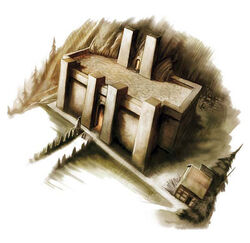
The temple of Mystra was meant to be good for Wheloon...
The priestess Naedaenya Arthas met with Sarp Redbeard around Ches of 1374 DR to request the construction of a temple of Mystra in Wheloon. She persuaded him that it would open a market for magical items, spell components, and lore, and boost the city's economy. She also paid hefty bribes to Redbeard. He approved construction, and granted the priests tax breaks. He told Whelunians it would bring more people and trade and make Wheloon important. The temple was sited on the crumbling foundations of the ruined citadel that lay on the northern edge of town. Using magically assisted construction techniques, it took only months to build, and was nearly completed in Eleint that year. It was Cormyr's only temple to Mystra, but many Whelunians had little need to worship the goddess of magic, and it became only a local curiosity.[2][15] Then, on Eleint 6, an itinerant cleric of Mystra, Tunaster Dranik, and a group of adventurers in the service of Mystra discovered the temple to be a front for Sharran cultists to kidnap magically gifted citizens and travelers in a plot to tear a rift in the Weave.[16][17] Wheloon's Purple Dragons investigated the matter and Constal Maximanus Tholl brought the adventurers to an audience with Redbeard, who requested they continue their investigations and follow the cultists into the Vast Swamp. Redbeard, Tholl, and the Purple Dragons remained in Wheloon to guard the city and the temple.[18] After pursuing the cult, the adventurers foiled the plot and returned on Eleint 13, and helped open up trade agreements between Cormyr and the Sharptooth tribe of lizardfolk in the Vast Swamp.[16][17]
Post-Spellplague[]
After the Spellplague in the Year of the Heretic's Rampage, 1473 DR,[19] King Foril decreed that Wheloon be transformed into a prison city, sentencing all those inside to be prisoners for life, sealed in by physical and magical barriers. The decision was made following unprecedented activity by worshipers of Shar in the city, as well as evidence of their alliance with Netheril.[20][5] Suspected worshipers of Shar, Shadovar sympathizers and spies, and any others who offended the crown were put over the wall and left to survive on their own.[5]
By the Year of the Ageless One, 1479 DR,[21] Wheloon was a dark prison city, no longer a trade hub, and the streets were controlled by gangs of thugs.[5][22] Even so, a small group of nobles, courtiers, and priests of Chauntea and Lliira begun petitioning the Crown to open the city. They insisted the Purple Dragons couldn't prove all the imprisoned were faithful of Shar and believed that the children born since the city was sealed ought to be given the chance at a righteous life.[20]
Demographics[]
Wheloon was originally only lightly populated, beginning as a town of 1,500 people circa 1367 DR,[3] but refugees from Arabel changed that, causing a small population explosion.[2] It rose rapidly to around 3,700 circa 1370 DR,[4] and then to a small city of 6,661 people in 1372 DR[1] and leveling at 6,692 in 1374 DR.[2] However, Lord Redbeard kept poor records of the number of people in Wheloon and other lands he governed, meaning that the population figures were also notoriously uncertain.[23][note 1]
It had a mixed population, consisting of 82% humans, 6% halflings, 4% dwarves, 4% gnomes, 2% half-elves, 1% elves, and 1% half-orcs.[2]
Following Wheloon's transformation into a prison city after the Spellplague, Wheloon's population fell to 3,000 by 1479 DR.[5]
Government & Politics[]
The Lord of Wheloon through the mid–14th century was Lord Sarp Redbeard, who ruled in the name of King Azoun IV.[1][2][4][7][6][9] He was famously headstrong and acted virtually independently of the crown. He often disagreed with the crown's policies, usually refusing to support them if they did not benefit Wheloon.[1][7][6][9] Redbeard was popular and well-liked by his people, who felt he kept the Purple Dragons from meddling in their affairs too much.[1][7][6][9] The Whelunians respected his focus on them and their city.[2] Redbeard also often sided with the many farmers who dwelt in his domain, so he was popular among them as well.[24]
Due to Redbeard's poor population records, the taxes paid to the crown fluctuated.[23] He was generally negligent on taxation and tended to ignore the contribution of smugglers to the local economy.[2]
The Heralds of Faerûn had an office here, titled "Wheloon". In the 1350s and 60s DR, this position was filled by Elaerue Estspirit, who also served as assistant, clerk, and record-keeper to Redbeard.[3][7][6][25]
The Huntcrown noble house had holdings in Wheloon.[3]
A magistrate based here ruled on legal disputes, both in Wheloon and in other settlements in Redbeard's domain, like Ghars.[26]
Defenses[]
Sprawling on both sides of a river, and with no town walls or natural barriers, Wheloon was difficult to defend.[2]
The Wheloon Watch was a militia force of volunteers, all merchants and tradesmen by day. They were basic fighters, equipped with leather armor, maces, short swords, daggers, and crossbows.[3][8][14] They were based out of the Wheloon Watch House.[2][4]
The Purple Dragons enforced law and order in Wheloon. Their force in the city numbered approximately 150, and they were led by Constal Maximanus Tholl around 1374 DR.[2] A typical road patrol numbered fourteen and consisted of mounted fighters equipped with chain mail, light lances, longswords, maces, and daggers. Around 1358 DR, a patrol leader was Roadcaptain Thondar.[8] They had a barracks and armory near the Wheloon Watch House.[4][note 2]
As a prison city in the 15th century, Wheloon at last had a wall built around it, albeit to keep the people in.[5]
Economy & Trade[]
Wheloon lay at the intersection of the two most valuable and heavily trafficked trade routes in eastern Cormyr: the Way of the Manticore from Sembia and the Wyvernflow river between the Wyvernwater and the Sea of Fallen Stars. The town grew and prospered off the Wyvern Ferry that linked both sides of the river, as merchant caravans, barges, and ships increasingly passed through or offloaded their cargo here, and it served as a barge transshipment center. Through the late 1360s DR, Wheloon became a cheaper and less crowded alternative to the ports of Suzail and Marsember.[1][2][4][7][6][9]
It was a busy and prosperous town, ever growing through the 1360s DR, with wealth and entrepreneurs, known as "hothands".[4] There was strong competition between shopkeepers and craftsfolk.[27] Though there were no major merchants, the talented craftsfolk often allied to invest in new ventures. Cut-price transportation services were a favorite, though they had to hire guards to defend themselves from bandits hired by established costers trying to crush the upstart competition.[4]
There was a big population of artisans and craftsfolk in Wheloon,[28] who were famous for the quality of their work, thanks to their attention to detail and great patience at their craft.[29] They included many boatmakers and sailmakers, and basketweavers and clay-potters, as well as as wagonwrights.[1][2][4][7][6][9][28]
Local agriculture was established in the farming of apples, blueberries, grapes, melons, peaches, pumpkins, raspberries, and wheat. Wheloon's port shipped out more bulk food and grain than anywhere else in Cormyr, and returned hefty profits.[4] Among others, one new trade in Wheloon at the time was the breeding and training of bluebirds and ferrets for pets. These animals grew in popularity in Cormyr in the 1360s DR.[4] In the lumber industry, Whelunians extensively logged the Hermit's Wood.[30] A local "hothands", Sarliman Eurdoe, imported the rosecork from Prespur for its valued properties. The rosecork trees went on to flourish by the southern tributaries of the Wyvernflow.[4][31]
Following the Spellplague and Wheloon's transformation into a prison city, it naturally stopped being a trade hub.[22]
Culture & Society[]
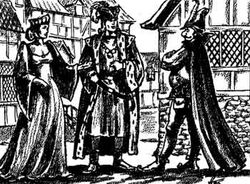
Merchants meeting in the streets of Wheloon.
Wheloon was an industrious, busy, and prosperous place. Whelunians were often going about some business and traveling to one place or another within the town.[2] Most were hardworking craftsfolk who, though not rich, earned enough money and had enough time on their hands to enjoy their lives.[2] Whelunian craftsfolk had an eye for fine detail and great patience for a task, and these traits were exhibited in the finished goods. These craftsfolk were famous for the quality of their work, and their reputation spread to distant lands.[29]
Unfortunately, they were preyed upon by the many thieves of Wheloon. These thieves shared the craftsmen's eye for detail, composure, and methodical nature. It took them longer to pick a lock than a typical thief, but they could do so more reliably.[29]
Most deceased Whelunians were buried in the Green, a field outside town. However, some buried their family members on their own property, in small, private cemeteries.[2] For centuries, Whelunians used Rathool's Pond as a burial site for war heroes and those slain in battle, though they'd discontinued the practice by the mid–13th century DR.[2][32][33]
Post-Spellplague[]
Following Wheloon's transformation into a prison city, it became a dumping ground for suspected Shar-worshipers, Shadovar spies and sympathizers, and others who'd offended the Cormyrean rulers, as well as those already trapped inside. They were left to look after themselves, and life was hard and dangerous.[5] For protection, people gathered into gangs. There were many of these gangs, all rivals, often ruthless, and they ruled the streets and dominated the town.[5][22]
These Whelunians bitterly resented Cormyr for abandoning them, but also despised self-righteous do-gooders, and believed all people had darkness in them. They were loyal only to other members of their gang, or an adopted group, and uncaring of outsiders. They were often skilled in thievery and in resisting charm magic.[22] A common mark of a Whelunian was their tattoos, both the prisoner tattoos made before they were put over the walls and the gang tattoos earned inside. These could be extensive and recorded their ordeals. They marked escapees, and had to be disguised elsewhere in Cormyr.[5][22]
Escaping was very difficult, so much so that "to escape from Wheloon" came to mean to accomplish a difficult task. However, it was not impossible. Those who escaped lived in fear of recapture, and usually tried to find a new home far outside Cormyr.[5][22]
Description[]
Wheloon in the mid–14th century was a mid-sized town with over two hundred significant buildings,[7][6][9] to a small city.[1][2] It straddled both sides of the Wyvernflow river, with the center of town historically on the western side,[2] which was both the longest settled and the most prosperous.[4] The eastern side grew later, especially when it was settled by refugees of Arabel.[2] Without town walls or other natural barriers to contain it, the town sprawled outwards in all directions. The terrain beneath was hilly, so the meandering streets wound around them, or followed the whims of Whelunian builders, as there was no attempt at urban planning.[2] The streets were cobbled and patched, and often muddy. Road-lamps provided light to Wheloon's streets after dark.[8]
Wealthy and fast-growing, Wheloon did not have many permanent buildings, and few stood out as especially grand or particularly rundown. Still, they were always growing, expanding, and improving.[2][4] Most were built of stone, and some had upper stories of stucco and timber.[8] Others were fashioned of wood or wattle.[2]
Many of Wheloon's businesses and houses were roofed with bright green slate shingles. These came from the nation's largest quarry situated not far to the north of the city, a monster-haunted pit near Masark's Grove. This native slate was dark green when first cut, but brightened on exposure to the sun. Travelers were often impressed by the vibrant green roofs, and the buildings were nicknamed "the jade towers of Wheloon" and the city itself the "Jade Towers".[1][2][7][6][9] A few other buildings and warehouses had thatched roofs instead.[4][8]
Whelunians built their own houses and operated small businesses from them. Bedrooms and kitchens often doubled as workshops as a result. Still, they were proud of their homes, whatever they were made from or did in them, and often worked on improving them.[2]
Wheloon was always seen to be a busy place, with people traveling back and forth on business, while drovers moving animals and merchant caravans often came through. It was noisy with the sounds of labor, of wagons and animals, of people talking and calling. Such things went on through the day and deep into the night.[2][4][8]
The greatest landmark in Wheloon was the Wyvernflow River that divided it in two. The Wyvern Ferry Route operated ferries over the water, joined the two halves of the town together and linking both ends of the Way of the Manticore. With heavy traffic and many Whelunians owning boats, fares remained cheap at one copper piece, and ferries ran day and night.[1][2][7][6][8][9] Two inns lay on opposite ends of the ferry route: the Wyvern Watch Inn on the west bank and the Lantern Inn and Boathouse on the east.[4]
On the west bank, the Way of the Manticore crossed Wheloon Way, with the Wheloon Watch House, the Purple Dragon barracks, Wheloon Jail, and the armory all standing on one corner of the intersection. North up Wheloon Way could be found Oldstone Hall, the lord's manor, standing opposite the Wheloon Moothouse, which, unfortunately, lay near Haldos's Fine Butchery.[4][32] Another key road in town was Westbank March, a farm road that ran from the heights north of Wheloon down to follow the Wyvernflow to the coast.[34] Impil Street was the site of many warehouses owned by the Cormyrean Coins Coster.[2]
The Green was a large field southwest of the town. The majority of deceased Whelunians were buried in the Green, but small herds of livestock, owned by a few city-folk, were also allowed to graze there. The Green was ringed by a communally owned wooden fence.[2]
Rathool's Pond lay within the town, on its northwestern side. For centuries, Whelunians used it as a burial site for war heroes and those slain in battle. The water turned orange-brown with rust from their armor and weapons.[2][32][33] By the mid–13th century DR, Rathool's Pond was the local swimming pool and fishing hole, but it was considered unsafe for drinking or fishing. However, the priests of Chauntea at the Harvest Hall actually opposed efforts to clean it up, fearing the dead would be disturbed and their spirits grow angry.[2][33]
Notable locations[]
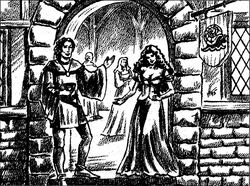
A welcome to the Silvery Sembian Snail.
- Official buildings
- Oldstone Hall • Wheloon Jail • Wheloon Moothouse • Wheloon Watch House
- Shops & Businesses
- 23 Impil Street • Basult's Books • The Blackbard • Cormyrean Coins Coster • Falconstar Wayshipping • The Fish House • Haerldoun's Helms and Shields • Haldos's Fine Butchery • Hanno's Herbs and Medicines • Rallogar Hardware • Redbeard Rental Storage and Shipping • Sendever's Stables • Slowtooth Weaponry • Wyvern Ferry Route • Wheloon Tack & Leather • Woumar's Wheloon Mill
- Inns
- Immerhand Inn • Lantern Inn and Boathouse • Wyvern Watch Inn
- Taverns
- Scarlet Sheath • Silvery Sembian Snail • Sleeping Cat
- Temples & Shrines
- God's Grove • Harvest Hall • Temple of Mystra
- Other Locations
- The Green • Rathool's Pool
- Roads & Streets
- Impil Street • Way of the Manticore • Westbank March • Wheloon Way
Appendix[]
Notes[]
- ↑ The Cormyr sourcebook lists Wheloon with a population of 1,500 at an estimated date of 1367 DR, while Volo's Guide to Cormyr gives a population of more than double that, at 3,700 at an estimated date of 1369 DR, only two years later. The reason for this rapid rise, still prior to the evacuation of Arabel, is not known. This figure is assumed to be more appropriate a year later, after the evacuation. Lord Redbeard's poor records might also be to blame for this discrepancy.
- ↑ The Cormyr sourcebook states that Wheloon only has a militia, while it and the 1st-, 2nd-, and 3rd-edition campaign settings state that Lord Redbeard keeps the Purple Dragons out of Whelunians' lives, and perhaps the town itself. This does not account for the Purple Dragons mentioned in prior (Waterdeep) and later (Volo's Guide to Cormyr and Cormyr: The Tearing of the Weave) sources. Taken together, it is possible that the Waterdeep appearance was temporary, owing to the emergency of the Time of Troubles in 1358 DR or a visiting patrol, while the Purple Dragons were stationed there permanently after 1367 DR and before around 1369 DR.
Maps[]
Appearances[]
Adventures
Novels & Short Stories
Video Games
Neverwinter Nights series (Wyvern Crown of Cormyr • Darkness over Daggerford) • Neverwinter
Organized Play & Licensed Adventures
The Black Knight of Arabel
References[]
- ↑ 1.00 1.01 1.02 1.03 1.04 1.05 1.06 1.07 1.08 1.09 1.10 1.11 Ed Greenwood, Sean K. Reynolds, Skip Williams, Rob Heinsoo (June 2001). Forgotten Realms Campaign Setting 3rd edition. (Wizards of the Coast), p. 113. ISBN 0-7869-1836-5.
- ↑ 2.00 2.01 2.02 2.03 2.04 2.05 2.06 2.07 2.08 2.09 2.10 2.11 2.12 2.13 2.14 2.15 2.16 2.17 2.18 2.19 2.20 2.21 2.22 2.23 2.24 2.25 2.26 2.27 2.28 2.29 2.30 2.31 2.32 2.33 2.34 2.35 2.36 2.37 2.38 2.39 2.40 2.41 2.42 Richard Baker, Bruce R. Cordell, David Noonan, Matthew Sernett, James Wyatt (March 2007). Cormyr: The Tearing of the Weave. (Wizards of the Coast), p. 148–152. ISBN 978-0-7869-4119-3.
- ↑ 3.0 3.1 3.2 3.3 3.4 3.5 3.6 Eric Haddock (1994). Cormyr. (TSR, Inc). ISBN 1-56076-818-5.
- ↑ 4.00 4.01 4.02 4.03 4.04 4.05 4.06 4.07 4.08 4.09 4.10 4.11 4.12 4.13 4.14 4.15 4.16 4.17 4.18 4.19 4.20 Ed Greenwood (July 1995). Volo's Guide to Cormyr. (Wizards of the Coast), pp. 87, 104–105. ISBN 0-7869-0151-9.
- ↑ 5.0 5.1 5.2 5.3 5.4 5.5 5.6 5.7 5.8 5.9 Bruce R. Cordell, Ed Greenwood, Chris Sims (August 2008). Forgotten Realms Campaign Guide. Edited by Jennifer Clarke Wilkes, et al. (Wizards of the Coast), pp. 105–106. ISBN 978-0-7869-4924-3.
- ↑ 6.00 6.01 6.02 6.03 6.04 6.05 6.06 6.07 6.08 6.09 6.10 6.11 Ed Greenwood, Jeff Grubb (August 1987). “Cyclopedia of the Realms”. In Karen S. Martin ed. Forgotten Realms Campaign Set (TSR, Inc.), pp. 33, 89. ISBN 0-88038-472-7.
- ↑ 7.00 7.01 7.02 7.03 7.04 7.05 7.06 7.07 7.08 7.09 7.10 Eric Haddock (1994). Cormyr. (TSR, Inc), p. 31. ISBN 1-56076-818-5.
- ↑ 8.0 8.1 8.2 8.3 8.4 8.5 8.6 8.7 8.8 Ed Greenwood (1989). Waterdeep (adventure). (TSR, Inc), pp. 6–9, map. ISBN 0-88038-757-2.
- ↑ 9.0 9.1 9.2 9.3 9.4 9.5 9.6 9.7 9.8 9.9 Ed Greenwood, Julia Martin, Jeff Grubb (1993). Forgotten Realms Campaign Setting 2nd edition (revised), A Grand Tour of the Realms. (TSR, Inc), p. 57. ISBN 1-5607-6617-4.
- ↑ Richard Baker, Bruce R. Cordell, David Noonan, Matthew Sernett, James Wyatt (March 2007). Cormyr: The Tearing of the Weave. (Wizards of the Coast), pp. 4, 7, 19. ISBN 978-0-7869-4119-3.
- ↑ Ed Greenwood, Jeff Grubb (April 1998). Cormyr: A Novel. (TSR, Inc.), chap. 20, p. 294. ISBN 0-7869-0710-X.
- ↑ Brian R. James, Ed Greenwood (September 2007). The Grand History of the Realms. Edited by Kim Mohan, Penny Williams. (Wizards of the Coast), p. 109. ISBN 978-0-7869-4731-7.
- ↑ Eric Haddock (1994). Cormyr. (TSR, Inc), p. 32–33. ISBN 1-56076-818-5.
- ↑ 14.0 14.1 Troy Denning (July 2003). Waterdeep. (Wizards of the Coast), pp. 32–33, 39. ISBN 0-7869-3111-6.
- ↑ Richard Baker, Bruce R. Cordell, David Noonan, Matthew Sernett, James Wyatt (March 2007). Cormyr: The Tearing of the Weave. (Wizards of the Coast), pp. 3, 4, 18. ISBN 978-0-7869-4119-3.
- ↑ 16.0 16.1 Richard Baker, Bruce R. Cordell, David Noonan, Matthew Sernett, James Wyatt (March 2007). Cormyr: The Tearing of the Weave. (Wizards of the Coast), p. 119. ISBN 978-0-7869-4119-3.
- ↑ 17.0 17.1 Brian R. James, Ed Greenwood (September 2007). The Grand History of the Realms. Edited by Kim Mohan, Penny Williams. (Wizards of the Coast), p. 156. ISBN 978-0-7869-4731-7.
- ↑ Brian R. James, Ed Greenwood (September 2007). The Grand History of the Realms. Edited by Kim Mohan, Penny Williams. (Wizards of the Coast), p. 156. ISBN 978-0-7869-4731-7.
- ↑ Brian Cortijo (January, 2012). “Cormyr Royale: The Royal Court of the Forest Kingdom”. Dungeon #198 (Wizards of the Coast) (198)., p. 62. Archived from the original on 2015-11-03. Retrieved on 2017-07-07.
- ↑ 20.0 20.1 Brian Cortijo (January, 2012). “Cormyr Royale: The Royal Court of the Forest Kingdom”. Dungeon #198 (Wizards of the Coast) (198)., p. 56. Archived from the original on 2015-11-03. Retrieved on 2017-07-07.
- ↑ Bruce R. Cordell, Ed Greenwood, Chris Sims (August 2008). Forgotten Realms Campaign Guide. Edited by Jennifer Clarke Wilkes, et al. (Wizards of the Coast), p. 4. ISBN 978-0-7869-4924-3.
- ↑ 22.0 22.1 22.2 22.3 22.4 22.5 Rob Heinsoo, Logan Bonner, Robert J. Schwalb (September 2008). Forgotten Realms Player's Guide. (Wizards of the Coast), pp. 88, 89. ISBN 978-0-7869-4929-8.
- ↑ 23.0 23.1 Eric Haddock (1994). Cormyr. (TSR, Inc), p. 44. ISBN 1-56076-818-5.
- ↑ Eric Haddock (1994). Cormyr. (TSR, Inc), p. 51. ISBN 1-56076-818-5.
- ↑ Ed Greenwood, Julia Martin, Jeff Grubb (1993). Forgotten Realms Campaign Setting 2nd edition (revised), A Grand Tour of the Realms. (TSR, Inc), p. 44. ISBN 1-5607-6617-4.
- ↑ Chet Williamson (July 1998). Murder in Cormyr. (TSR, Inc.), chap. 23, pp. 149–150. ISBN 0-7869-0486-0.
- ↑ Ed Greenwood (July 1995). Volo's Guide to Cormyr. (Wizards of the Coast), p. 108. ISBN 0-7869-0151-9.
- ↑ 28.0 28.1 Eric Haddock (1994). Cormyr. (TSR, Inc), p. 52. ISBN 1-56076-818-5.
- ↑ 29.0 29.1 29.2 William W. Connors (November 1995). Wizards and Rogues of the Realms. Edited by Anne Gray McCready. (TSR, Inc), p. 92. ISBN 0-7869-0190-X.
- ↑ Ed Greenwood, Julia Martin, Jeff Grubb (1993). Forgotten Realms Campaign Setting 2nd edition (revised), A Grand Tour of the Realms. (TSR, Inc), p. 50. ISBN 1-5607-6617-4.
- ↑ James Butler, Elizabeth T. Danforth, Jean Rabe (September 1994). “The Settled Lands”. In Karen S. Boomgarden ed. Elminster's Ecologies (TSR, Inc), p. 12. ISBN 1-5607-6917-3.
- ↑ 32.0 32.1 32.2 Ed Greenwood (July 1995). Volo's Guide to Cormyr. (Wizards of the Coast), pp. 105, 107. ISBN 0-7869-0151-9.
- ↑ 33.0 33.1 33.2 James Butler, Elizabeth T. Danforth, Jean Rabe (September 1994). “The Settled Lands”. In Karen S. Boomgarden ed. Elminster's Ecologies (TSR, Inc), p. 5. ISBN 1-5607-6917-3.
- ↑ Ed Greenwood (July 1995). Volo's Guide to Cormyr. (Wizards of the Coast), p. 112. ISBN 0-7869-0151-9.

